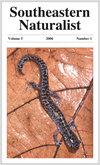Decline of Tricolored Bats (Perimyotis subflavus) in Florida Caves in Winter
IF 0.6
4区 环境科学与生态学
Q4 BIODIVERSITY CONSERVATION
引用次数: 0
Abstract
Abstract Perimyotis subflavus (Tricolored Bat) was once common across the eastern United States, but in recent years, populations have declined drastically across the species' range, mainly because of mortality caused by white-nose syndrome. The fungus that causes white-nose syndrome has not been detected in Florida, and therefore the state may represent an important stronghold for the Tricolored Bat. We counted Tricolored Bats in Florida caves in January and February from 2014 to 2022 to better determine population size and document trends in abundance before the potential arrival of white-nose syndrome. We modeled trends in counts over time on the entire count dataset and on subsets based on karst region and cave size. In addition, we fit mixed-effects Poisson regression models to understand the influence of cave characteristics and investigator disturbance on Tricolored Bat counts. Models of statewide bat counts exhibited a strongly decreasing trend (mean = -17% per year) with a 67% decrease overall across the study period. Warmer temperatures on the day of survey were associated with lower counts, and longer caves were associated with higher counts. We did not find an impact of investigator disturbance on bat counts. Although ambient temperatures influenced observed numbers, we cannot exclude the possibility that these long-term declines are the result of undetected or indirect losses from white-nose syndrome. It is unknown if Tricolored Bats roosting in other locations that are not routinely monitored (e.g., trees) are experiencing similar declines; thus, incorporating other monitoring methods would improve the understanding of Tricolored Bat population trends.佛罗里达洞穴中冬季三色蝙蝠数量的减少
三色蝙蝠(periimyotis subflavus)曾经在美国东部很常见,但近年来,该物种的种群数量急剧下降,主要原因是白鼻综合征造成的死亡。在佛罗里达州还没有发现引起白鼻综合症的真菌,因此该州可能是三色蝙蝠的重要据点。我们在2014年至2022年的1月和2月对佛罗里达州洞穴中的三色蝙蝠进行了统计,以更好地确定种群规模,并在潜在的白鼻综合征到来之前记录丰度趋势。我们在整个计数数据集和基于喀斯特区域和洞穴大小的子集上模拟了计数随时间的趋势。此外,我们拟合了混合效应泊松回归模型,以了解洞穴特征和研究者干扰对三色蝙蝠数量的影响。全州蝙蝠数量模型显示出强烈的下降趋势(平均每年-17%),在整个研究期间总体下降67%。调查当天的温度越高,计数越低,而洞穴越长,计数越高。我们没有发现研究者干扰对蝙蝠数量的影响。虽然环境温度影响了观测到的数量,但我们不能排除这些长期下降是白鼻综合征未被发现或间接损失的结果的可能性。目前尚不清楚栖息在其他不受常规监测的地点(如树木)的三色蝙蝠是否也在经历类似的下降;因此,结合其他监测方法将提高对三色蝙蝠种群趋势的认识。
本文章由计算机程序翻译,如有差异,请以英文原文为准。
求助全文
约1分钟内获得全文
求助全文
来源期刊

Southeastern Naturalist
环境科学-生态学
CiteScore
1.20
自引率
16.70%
发文量
31
审稿时长
18-36 weeks
期刊介绍:
The Southeastern Naturalist covers all aspects of the natural history sciences of terrestrial, freshwater, and marine organisms and the environments of the southeastern portion of North America, roughly bounded from North Carolina south to Florida, west to Texas, north to Oklahoma, and east back to North Carolina. Manuscripts based on field studies outside of this region that provide information on species within this region may be considered at the Editor’s discretion.
 求助内容:
求助内容: 应助结果提醒方式:
应助结果提醒方式:


